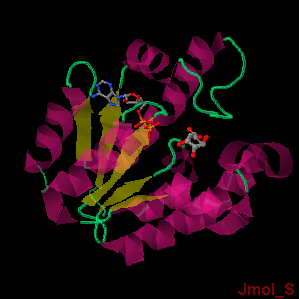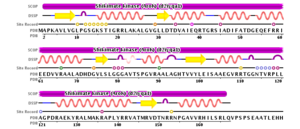Sandbox Reserved 763
From Proteopedia
| This Sandbox is Reserved from Sep 25, 2013, through Mar 31, 2014 for use in the course "BCH455/555 Proteins and Molecular Mechanisms" taught by Michael B. Goshe at the North Carolina State University. This reservation includes Sandbox Reserved 299, Sandbox Reserved 300 and Sandbox Reserved 760 through Sandbox Reserved 779. |
To get started:
More help: Help:Editing |
Contents |
Shikimate Kinase
|

Shikimate kinase (SK) is an enzyme which participates in the fifth step of the shikimate pathway. The functional role shikimate kinase plays in this pathway is to catalyze the ATP-dependent phosphorylation of shikimate into shikimate 3-phosphate (3-phosphoshikimate). This aids in the synthesis of chorismate, which is the precursor to aromatic amino acids and secondary metabolites. Shikimate kinase belongs to the nucleoside monophosphate (NMP) kinase family, which phosphorylates a protein leading to a functional change in the phosphorylated protein. SK is of the transferase class, which acts to transfer a functional group from the donor to acceptor molecule. The protein fold consists of 8 α-helices and 5 β-strands. The length of shikimate kinase is 173 residues and it is found in the cytoplasm. This is a subclass of α/β proteins, meaning an α/β domain exists. SK is composed of Molecule A and B, which together form the asymmetric unit, with SK functioning as a monomer. SK consists of the CORE, LID, and substrate-binding domains. ATP is the co-substrate while magnesium ion is the co-factor. The shikimate pathway is present in bacteria, fungi, higher plants, algae, and apicomplexan. This enzyme has been experimentally observed predominantly in the organism Mycobacterium tuberculosis, but also in Helicobacter pylori, Bacteroides thetaiotaomicron, Campylobacter jejuni, Aquifex aeolicus, Coxiella burnetii, Arabidopsis thaliana. The aroK gene encodes for SK in Mycobacterium tuberculosis. This enzyme is a protein target for rational drug design, which holds great potential due to shikimate kinase being absent in mammals.
Structure
The crystal structure of 2dfn from the Protein Data Bank [1] showing shikimate kinase from Mycobacterium tuberculosis complexed with ADP and shikimate is shown to the right as the .
3D Structures in Different Organisms
Crystal structure have been reported for SK alone, as a binary complex, and as a ternary complex.
Mycobacterium tuberculosis
2iyt - MtSK (unliganded, open lid)
2iyw - MtSK (open lid) + MgATP
2iys - MtSK (open lid) + shikimate
2iyu, 2iyv - MtSK (open lid) + ADP
1l4y, 2dft, 1l4u - MtSK + MgADP
2iyw - MtSK (open lid) + MgATP
3baf - MtSK + AMP-PNP
2dfn, 2iyq, 1u8a - MtSK + ADP + shikimate
2iyx - MtSK + shikimate + sulfate
2iyy - MtSK + shikimate-3-phosphate + sulfate
2iyz - MtSK + ADP + shikimate-3-phosphate
4bqs - MtSK + ADP + shikimic acid
1we2 - MtSK + MgADP + shikimic acid
2g1j - MtSK + AMPPCP (ATP analogue)+ shikimic acid
1zyu - MtSK + AMPPCP + shikimate
Helicobacter pylori
1zuh - HpSK
3mrs - HpSK (mutant)
1zui - HpSK + shikimate
3n2e - HpSK (mutant) + inhibitor
3muf - HpSK + ADP + shikimate-3-phosphate
Other Organisms
2pt5 - SK - Aquifex Aeolicus
3trf - SK - Coxiella burnetii
3vaa - SK - Bacteroides thetaiotaomicron
1via - SK - Campylobacter jejuni
3nwj - SK - Arabidopsis thaliana
Secondary Structural Elements

Using 2iyq as an example, the secondary structure of shikimate kinase can be observed in terms of strands and helices shown . There are 5 strands, shown in yellow, and 9 helices (8 α-helices and a single 310 helix) which are shown in pink. Shown to the left is a 2D depiction of the secondary structural content of shikimate kinase (strands are yellow, helices are pink) and corresponding residues.
Isoforms
In Escherichia coli the shikimate kinase reaction is catalyzed by two different isoforms: SKI and SKII (Km= 20 μM Km= 200 μM, respectively) with 30% sequence identify. This is very unusual for two isoforms to occur in the middle of a biosynthetic pathway. Therefore, what may be occurring is that shikimate is at a branch point for two pathways. It is believed that SKII is the isoform participating in chorismate biosynthesis, while the role of the SKI isoform is unclear.[2]
Oligomeric State
SK is 173 amino acids in length and consists of two molecules: Molecule A from residues 1-112 and 128-173; Molecule B from residues 1-112 and 123-172. However, SK functions as a monomer with Molecules A and B forming the asymmetric unit. A disulfide bridge between Cys162 of Molecules A and B covalently links the two together. [2]
Through experiments involving size exclusion liquid chromatography and gel filtration chromatography, the oligomeric state of homogeneous MtSK was found. The molecular mass was found to be 20.7 kDa and when compared to the suggested value of 18.5 kDa, it was found that MtSK is a monomer in solution.[3]
Domains and Active Residues
There are three domains present in Shikimate kinase: the CORE domain, and substrate-binding (SB) domain, and LID domain. Each domain plays a role in binding and is related to the active residues. The binding site for nucleotides is in the CORE, shikimate binds in the substrate-binding domain, and once ATP or shikimate binds, the LID domain closes over the active site.[4]
The CORE domain spans from residues 9-17 (phosphate binding loop), 148-155 (AB-loop), and 101-110 (segment which includes alpha6 from 104-110). The SB domain is comprised of residues 32-93 and consists of a sub-domain from residues 32-61 which relates to the NMP-binding domain in NMP kinases. Finally, the LID domain consists of residues 112-124. A global motion leads to LID flapping over the active site upon binding the first substrate (whether shikimate or nucleotide). This causes a change from the open to closed conformation. [5]
Understanding the active residues involved in ligand binding is essential to design inhibitors. The P-loop of SK is often targeted by inhibitors as the ATP-binding site catalyzes the reaction (the transfer of a phosphate group). SK binds shikimate at R57, R116, and R132. Shikimate binding occurs with helices α2, α3, and α4 (N-terminal region).[2] The hydroxyl groups present on shikimate form contact with M10, D33, G79-81, E114, V44, F48, and R116. The most critical residues for SK catalysis include D33, F48, R57, R116, and R132. It is believed that R57, R132, and F48 form a favorable environment to interact with shikimate, thus triggering a series of conformational changes. Catalyzing the phosphorylation of the 3-hydroxyl group of shikimate is initiated as R116 contacts shikimate during a conformational change.[6]
Protein Fold
Protein folding from a random coil to native state with correct 3D structure is essential for proper protein function. The primary sequence of amino acids determines the folded structure. The topology of this enzyme is that of an α/β protein. An α/β/α fold exists consisting of a 5-stranded central parallel β-sheet (strand order 23145) and is flanked by 8 surrounding α-helices (α1 and α8 are to one side while α4, α5, and α7 are on the other side).[5][2]
Shikimate kinase is a convenient protein to use in protein folding studies. This is because it is one of the smallest kinases and is a monomeric enzyme. It has been shown that the proposed refolding model includes a rapid hydrophobic collapse and then a slower secondary structure formation.[7]
Methods Used to Solve/Study
Methods used in solving and/or studying the structure of SK include but are not limited to:
Crystallization (hanging-drop vapor-diffusion)
Molecular replacement methods for structure refinement
Multiple isomorphous replacement
Fourier calculations
Electrospray mass spectrometry
Dynamic light scattering
Circular Dichroism
Heavy atom derivatisation
Electron density mapping
Chromatography
Site-directed mutagenesis
Isothermal titration calorimetry
Mechanism of Action
Reaction Pathway
SK is found in the shikimate pathway, which is present in bacteria, fungi, higher plants, algae, and apicomplexan. This pathway serves to convert erythrose-4-phosphate into chorismate. Chorismate is a required intermediate in the biosynthesis of aromatic amino acids and secondary metabolites. Shikimate kinase is the catalyst for the fifth step of the shikimate pathway, where shikimate (SKM) is converted into shikimate-3-phosphate (S3P) and ATP serves as a co-substrate. It has been found experimentally that SK and shikimate binding involves two steps: substrate attaches to binding site in the first step and LID closure occurs in the second step.[5] As seen to the left, SK catalyzes the transfer of the γ phosphate group from from ATP to the 3-hydroxyl group of shikimate. This reaction is reversible, though the forward reaction forming S3P is the important reaction in chorismate synthesis.
Ligands
The liganded state of SK includes binary and ternary complexes.
Examples of ligands include:
Magnesium ions bind in the active site and hold influence over the position of shikimate hydroxy groups. This ion has a role in the transfer of the γ-phosphate of ATP to the 3-hydroxy group on shikimate. Chloride ions increase enzyme affinity for ADP and ATP and help to bind the nucleotide substrate in correct orientation.[8] Sulfate is replaced with MgATP in the ternary complex of SK to allow for the reaction to occur.[9] Sulfate interacts with Arg117 and distorts the nucleotide binding site[5] Sulfate binds and distorts the nucleotide binding site, leading to a large decrease of motion.[5]
Inhibitors
See the section on Implications or Possible Applications.
Implications or Possible Applications
Enzymes present in the shikimate pathway are important in microorganism survival yet absent in mammals. This means the enzymes of the SKM pathway are good candidates for antimicrobial agents, herbicides, inhibitors, and anti-parasitic drug target. [5][10]
Studies of potential inhibitors of SK have been conducted. This is important in the identification of potential drugs against tuberculosis (TB), which is caused by the pathogen Mycobacterium tuberculosis. TB is a curable infectious disease found mainly in developing countries. Though TB is curable, 100 million people are infected annually with approximately three million resulting deaths. TB resurges as a health problem due to multi-drug resistant, extensively drug resistant, and totally-drug resistant strains of Mt.[10]Disrupting the gene encoding MtSK, aroK, suggests that the shikimate pathway holds great promise for antimicrobial drug discovery.[6]
Inhibitors
One way potential MtSK inhibitors have been studied is through molecular docking experiments. These experiments predict the conformation of a receptor-ligand complex to analyze all possible positions of the ligand to make a selection for the best position. Virtual screening was also used to identify active molecules compared to a specific protein target. These studies have been able to confirm staurosporine as a known SK inhibitor.[10] Through docking studies, it has been found that is a competitive inhibitor for SK.[6] This inhibitor causes a shift in the SB domain due to E53 and R132 interacting instead of E53 and R57 as seen in the wild-type. The geometry of the active site is altered, leading to inhibition of SK.[6]
Additional Sites
Also see Shikimate kinase for further information.
References
- ↑ 1.0 1.1 Protein Data Bank http://www.rcsb.org/pdb/explore.do?structureId=2IYQ
- ↑ 2.0 2.1 2.2 2.3 Tino Krell et al. The three-dimensional structure of shikimate kinase. Journal of Molecular Biology http://www.sciencedirect.com.prox.lib.ncsu.edu/science/article/pii/S0022283698917557
- ↑ Leonardo Astolfi Rosado et al. The Mode of Action of Recombinant Mycobacterium tuberculosis Shikimate Kinase: Kinetics and Thermodynamics Analyses http://www.plosone.org/article/info:doi/10.1371/journal.pone.0061918
- ↑ UniProt http://www.uniprot.org/uniprot/P0A4Z2
- ↑ 5.0 5.1 5.2 5.3 5.4 5.5 Marcus D. Hartmann et al. Mechanism of Phosphoryl Transfer Catalyzed by Shikimate Kinase from Mycobacterium tuberculosis. Journal of Molecular Biology http://www.sciencedirect.com.prox.lib.ncsu.edu/science/article/pii/S0022283606011685#
- ↑ 6.0 6.1 6.2 6.3 Wen-Chi Cheng et al. Structures of Helicobacter pylori Shikimate Kinase Reveal a Selective Inhibitor-Induced-Fit Mechanism. PLoS One. http://www.ncbi.nlm.nih.gov/pmc/articles/PMC3306394/#!po=19.5652
- ↑ Eleonora Cerasoli et al. The refolding of type II shikimate kinase from Erwinia chrysanthemi after denaturation in urea. European Journal of Biochemistry http://onlinelibrary.wiley.com/doi/10.1046/j.1432-1033.2002.ejb.02862.x/pdf
- ↑ Marcio Vinicius Bertacine Dias et al. Effects of the magnesium and chloride ions and shikimate on the structure of shikimate kinase from Mycobacterium tuberculosis Structural Biology and Crystallization Communications http://www.ncbi.nlm.nih.gov/pmc/articles/PMC2330112/
- ↑ Marcus D. Hartmann et all. Mechanism of Phosphoryl Transfer Catalyzed by Shikimate Kinase from Mycobacterium tuberculosis. Journal of Molecular Biology. http://www.sciencedirect.com/science/article/pii/S0022283606011685
- ↑ 10.0 10.1 10.2 Carolina Pasa Vianna et al. Identification of new potential Mycobacterium tuberculosis shikimate kinase inhibitors through molecular docking simulations. Journal of Molecular Modeling http://link.springer.com.prox.lib.ncsu.edu/article/10.1007%2Fs00894-011-1113-5

